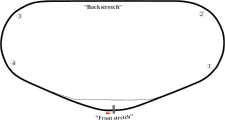1974 Daytona 500
| Race details | |||
|---|---|---|---|
| Race 2 of 30 in the 1974 NASCAR Winston Cup Series season | |||
 Track map of Daytona International Speedway showing mainly the speedway. | |||
| Date | February 17, 1974 | ||
| Location |
Daytona International Speedway Daytona Beach, Florida, U.S. | ||
| Course |
Permanent racing facility 2.5 mi (4.023 km) | ||
| Distance | 180 laps, 450 mi (724.205 km) | ||
| Scheduled Distance | 200 laps, 500 mi (804.672 km) | ||
| Weather | Temperatures reaching up to 81 °F (27 °C); wind speeds approaching 15 miles per hour (24 km/h)[1] | ||
| Average speed | 140.894 miles per hour (226.747 km/h) | ||
| Pole position | |||
| Driver | Wood Brothers Racing | ||
| Qualifying race winners | |||
| Duel 1 Winner | Bobby Isaac | Banjo Matthews | |
| Duel 2 Winner | Cale Yarborough | Richard Howard | |
| Most laps led | |||
| Driver | Richard Petty | Petty Enterprises | |
| Laps | 74 | ||
| Winner | |||
| No. 43 | Richard Petty | Petty Enterprises | |
| Television in the United States | |||
| Network | ABC's Wide World of Sports | ||
| Announcers |
Keith Jackson Jackie Stewart Chris Economaki | ||
The 1974 Daytona 500, the 16th running of the event, was won by Richard Petty (for the fifth time) after three hours, eleven minutes, and thirty-eight seconds of racing on February 17, 1974 at Daytona International Raceway in Daytona Beach, Florida, USA.
During the start of the 1974 NASCAR season, many races had their distance cut ten percent in response to the energy crisis of the year. As a result, the 1974 Daytona 500,[2][3] won by Richard Petty (his second straight, making him the first driver ever to do it), was shortened to 180 laps (450 miles), as symbolically, the race "started" on Lap 21 and the race is often known as the Daytona 450. The Twin 125 qualifying races (won by Bobby Isaac in a Banjo Matthews Chevrolet and Cale Yarborough in the Richard Howard Chevy prepared by Junior Johnson) were also shortened to 45 laps (112.5 miles).[4]
Summary
ABC Sports announced a week before the race that the event's second half would be televised live, opening with a recap of the event's opening laps. Keith Jackson handled play-by-play commentary with Jackie Stewart providing color commentary. Chris Economaki reported from pit road.
The race was the most competitive in Daytona history with 59 official lead changes (a record that stood until the 2011 Daytona 500, which saw 74 lead changes) among 15 leaders (this record was tied in 1989, then broken in 2006 at 18 and 2010 at 21, and 2011 with 22). Richard Petty and Donnie Allison combined to lead 29 times for 120 laps while other strong cars included Yarborough, Bobby Allison, A.J. Foyt (who started 35th), Coo Coo Marlin (started 31st), and pole-sitter David Pearson.
The race saw two dramatic changes in outcome in the final twenty laps. Petty cut a tire and had to pit under green with 19 to go, putting Donnie Allison into the lead, but with 11 to go in the trioval a backmarker's blown engine blew out both front tires on Allison's Chevy and Donnie spun out, then lost a lap limping to pit road and getting new tires. Petty's margin of victory was 47 seconds. Yarborough was second, followed by Ramo Stott, Marlin, Foyt, and Donnie Allison. Marlin might have finished second, but mistook the white flag for the checkered, since both were being displayed when they crossed the line to get the white flag, as Petty was right behind them. Marlin let off on the back straightaway, and lost second to Yarborough, while Stott, known at the time mostly for his USAC stock car prowess, followed to take third, while Marlin had to settle for fourth.
Notes
- ↑ "Weather of the 1974 Daytona 500". The Old Farmers' Almanac. Retrieved 2014-03-08.
- ↑ NASCAR.COM – Daytona Countdown: '74 – Jan 19, 2005
- ↑ Daytona At 50: Looking Back At 1974 by Michael Daly – CATCHFENCE.com
- ↑ Zeller, 84-87.